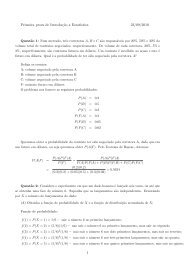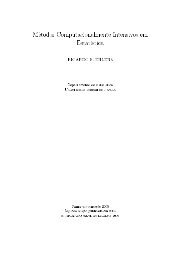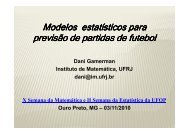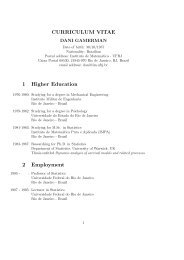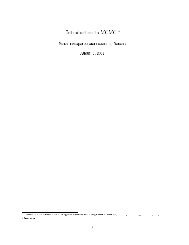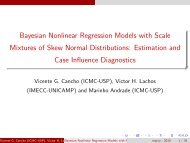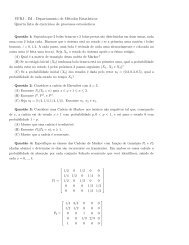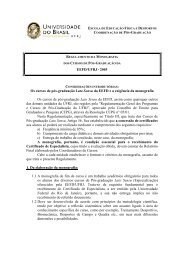Copulas: a Review and Recent Developments (2007)
Copulas: a Review and Recent Developments (2007)
Copulas: a Review and Recent Developments (2007)
Create successful ePaper yourself
Turn your PDF publications into a flip-book with our unique Google optimized e-Paper software.
such thatC(u; v) =© ru;v¡© ¡1 (u); © ¡1 (v) ¢ : (8)Note that the last theorem does not states that every copula C can be representedby a Gaussian copula, but that for each pair (u; v) 2 [0; 1] 2 always exist a memberof the family of the Gaussian copulas for which (8) holds whenever (7) is true. Infact, r u;v de¯ned by (7) is another local dependence measure related to the distancebetween the copula C <strong>and</strong> the Gaussian copula in [0; 1] 2 .4 Extreme value copulas <strong>and</strong> applicationsExtreme value multivariate modelling presents special features which rule out membersof the most well known general family of distributions, the elliptical family. Thevariables involved are usually non-exchangeable, positively associated (if not independent),with non-linear forms of dependence. In applications, additional complicationsarise from the usual scarcity of data.The asymptotic theory for extremes is well developed <strong>and</strong> univariate modelling basicallyfalls in one of the two categories: modelling st<strong>and</strong>ardized maxima through thegeneralized extreme value distribution (GEV), or modeling excesses over high thresholdsvia the generalized Pareto distribution (GPD). In the multivariate case thereare analogs of the two approaches, which follow from extensions of the Fisher <strong>and</strong>Tippett theorem, e.g. Fisher <strong>and</strong> Tippett (1928). However, the limit family has no¯nite parameterization, see Galambos (1978), Joe (1997), Reiss <strong>and</strong> Thomas (1997)<strong>and</strong> Coles (2001). It is possible to characterize sub-families of multivariate extremevalue distributions by assuming extreme value models for the margins <strong>and</strong> specifyingparametric models for the dependence function, see Pick<strong>and</strong>s (1981), Deheuvels(1978), de Haan (1985) <strong>and</strong> Tawn (1988), among others.The classical results in extreme value theory may be rewritten in terms of copulas.Let (X i;1 ;X i;2 ), i =1; 2;:::, be a sequence of r<strong>and</strong>om variables in (¡1; 1) 2 withjoint distribution H <strong>and</strong> marginals F Xi , i =1; 2. Let (M 1 ;M 2 )bethecomponentwisemaxima, i.e., M i = maxfX 1;i ; :::; X N;i g, i =1; 2. The bivariate version of the Fisher-Tippett theorem states that, if there exist sequences of normalizing constants a iN > 0,b iN 2 (¡1; 1), i =1; 2, such that the joint distributionµM1 ¡ b 1NP· x 1 ; M 2 ¡ b 2N· x 2 = H N (a 1N x 1 + b 1N ;a 2N x 2 + b 2N )a 2Na 1Nconverges in distribution as N !1to a proper distribution W (x 1 ;x 2 )withnondegeneratemargins, then W (x 1 ;x 2 ) is a bivariate extreme value distribution. Thismeans that H belongs to the domain of attraction of W ,denotedbyH 2 MDA(W ).28¥




